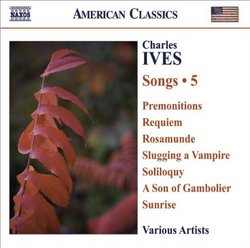| All Artists: Rob Gardner, Michael Cavalieri, Patrick Carfizzi, Charles Ives, Ian Howell, Janna Baty, Mary Phillips, Leah Wool, Tamara Mumford, Frederick Teardo, Eric Trudel, Douglas Dickson, J.J. Penna, Laura Garritson, Lielle Berman, Sumi Kittelberger, Jennifer Casey Cabot, Ryan MacPherson, Kenneth Tarver Title: Ives: Songs, Vol. 5 Members Wishing: 0 Total Copies: 0 Label: Naxos American Original Release Date: 1/1/2008 Re-Release Date: 10/28/2008 Genres: Pop, Classical Styles: Vocal Pop, Opera & Classical Vocal, Historical Periods, Modern, 20th, & 21st Century Number of Discs: 1 SwapaCD Credits: 1 UPC: 636943927328 |
Search - Rob Gardner, Michael Cavalieri, Patrick Carfizzi :: Ives: Songs, Vol. 5
 | Rob Gardner, Michael Cavalieri, Patrick Carfizzi Ives: Songs, Vol. 5 Genres: Pop, Classical |
Larger Image |
CD Details |
CD ReviewsIves's Songs from P to S Robin Friedman | Washington, D.C. United States | 01/21/2009 (5 out of 5 stars) "In a collection of six CDs in its "American Classics" series, Naxos has presented the complete songs of Charles Ives (1874-1954). The songs are arranged in alphabetical order and are performed by a group of young singers, pianists, and other musicians affiliated with the Yale University School of Music. Ives composed songs throughout his career. They range from sentimental parlor songs through songs based upon German lieder, to highly iconoclastic, difficult works in which Ives set a modernistic tone for American music. Ives set many different poets, including his own texts and those by his wife Harmony, together with works by American English, German, French and other writers. Because of the collage-like quality of Naxos's arrangement of the songs in alphabetical order, each of the CDs in the collection offers the listener the opportunity to hear a cross-section of Ives's songs.
This CD is the fifth and longest in the series with 40 songs and 80 minutes of music. It begins and ends with two of Ives's finest works in song. The CD begins with a setting of Robert Browning's "Paracelsus" composed in 1921. This late song opens with a lengthy, chordal, and dissonant piano prelude. Browning's text tells of the alchemist who seemed to equate himself to God in his power and knowledge. Gradually, the tone becomes more modest and subdued, as Paracelsus learns that "and with much power,always, always, much more love." Baritone Robert Gordon and pianist Eric Trudel valiantly perform this challenging work. The CD concludes with Ives's 1915 setting of a poem written in that year called "Swimmers" by Louis Untermeyer, who for many years edited anthologies of American poetry. The song opens with rolling wave-like passages in the piano. Untermeyer's poem speaks of pitting the swimmer's "feverish intensity of life" against the cold turbulent waves of the ocean. It is a song of surmounting obstacles and living bravely. This song, one of Ives's masterworks in the form, is performed by baritone Patrick Carfizzi accompanied by Eric Trudel. This CD also has the distinction of including Ives's first and his last song. Ives's composed the song "Slow March" in 1887 upon the burial of the family's beloved pet cat. Ives's final song, "Sunrise" dates from 1926 and was reconstructed from Ives's manuscript following his death. "Sunrise" is a lengthy, obscure song with a solo violin mediating between the piano and vocal lines. There are many other riches on this CD of Ives, both early and late. One of Ives's best-known songs is the early "Songs my Mother Taught Me" (1900) which sets lines also set by Dvorak. This is a short, sentimental song performed lovingly by soprano Mary Phillips and pianist J.I. Penna I was impressed with Phillips's singing both on this CD and in volume 6 of the series. Some other lovely early songs include "A perfect day" (1902),"Rosenzweige" (1902), and the simple love lyric "Song" of 1897. The song "A Son of a Gambolier" (1895) is distinguished by its chorus for kazoos and and for assorted wind instruments. It is in the latter, more difficult songs that Ives comes into his own. Many of the late songs on this CD have religious themes. Besided "Paracelsus", and "Sunrise" these songs include "Serenity" (1919), setting a text by John Greenleaf Whittier, "Peaks" (1923), "Premonitions" (1921), "Religion" (1921), "Requiem" (1911) setting a text by Robert Louis Stevenson, and "Soliloquy" (1916). These songs show Ives at his most transcendental and reflective. Songs with other themes by the later Ives include the "Romanzon di Central Park" (1911) which sets a text of some 12 words in three stanzas. This song rests uneasily on the border between sentimenality and parody of sentimentality. The short song "The Seer" (1921) is a visceral portrayal of the effect of old age. In "A Sea Dirge" (1925)Ives offers a pessimistic setting of Shakespeare's "Full Fathom Five" song for Ariel in "The Tempest." "The side show" (1921) is a brief satirical picture of urban lowlife similar to an earlier Ives song, "In the Alley." And in "The Rainbow" (1921), Ives offers an original setting of familiar verses by William Wordsworth. As do its companions, this CD includes informative program notes by Richard Whithouse. Naxos has made the texts of some of the songs available online. This Naxos series allows listeners interested in Ives's songs the opportunity to explore them in detail. With this review, I have completed my brief survey of the six CDs in this collection. I have greatly enjoyed these recordings and learned something about Ives's work as a song composer. I hope some readers will be encouraged by these reviews to explore Ives's songs for themselves. Robin Friedman" |
